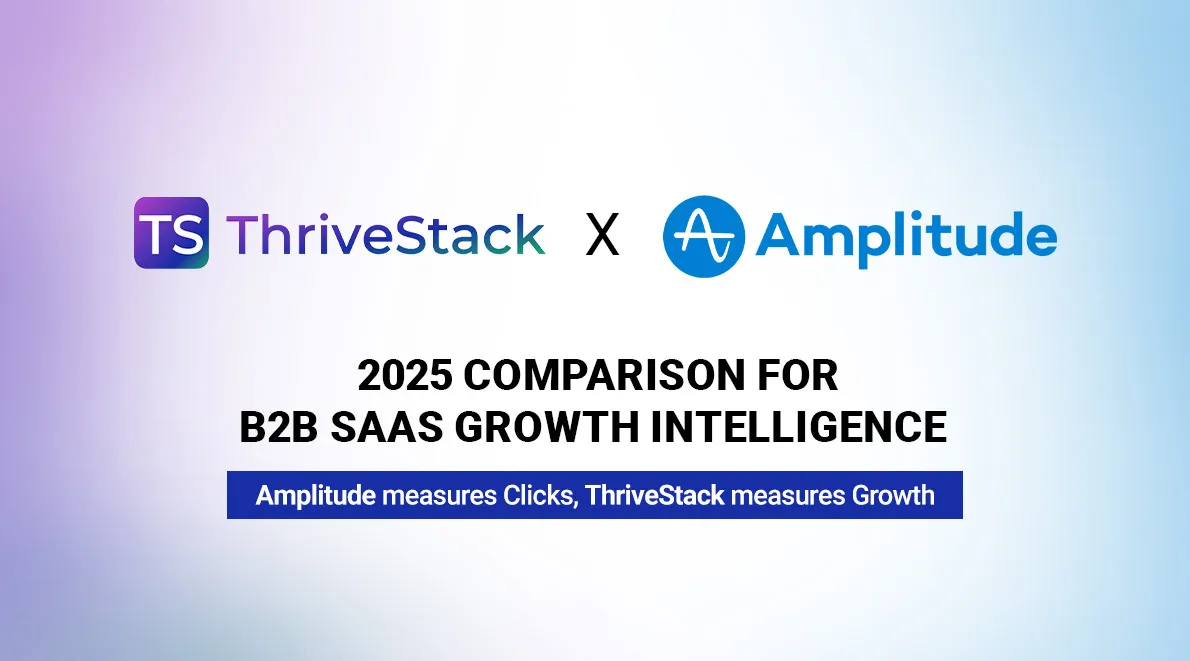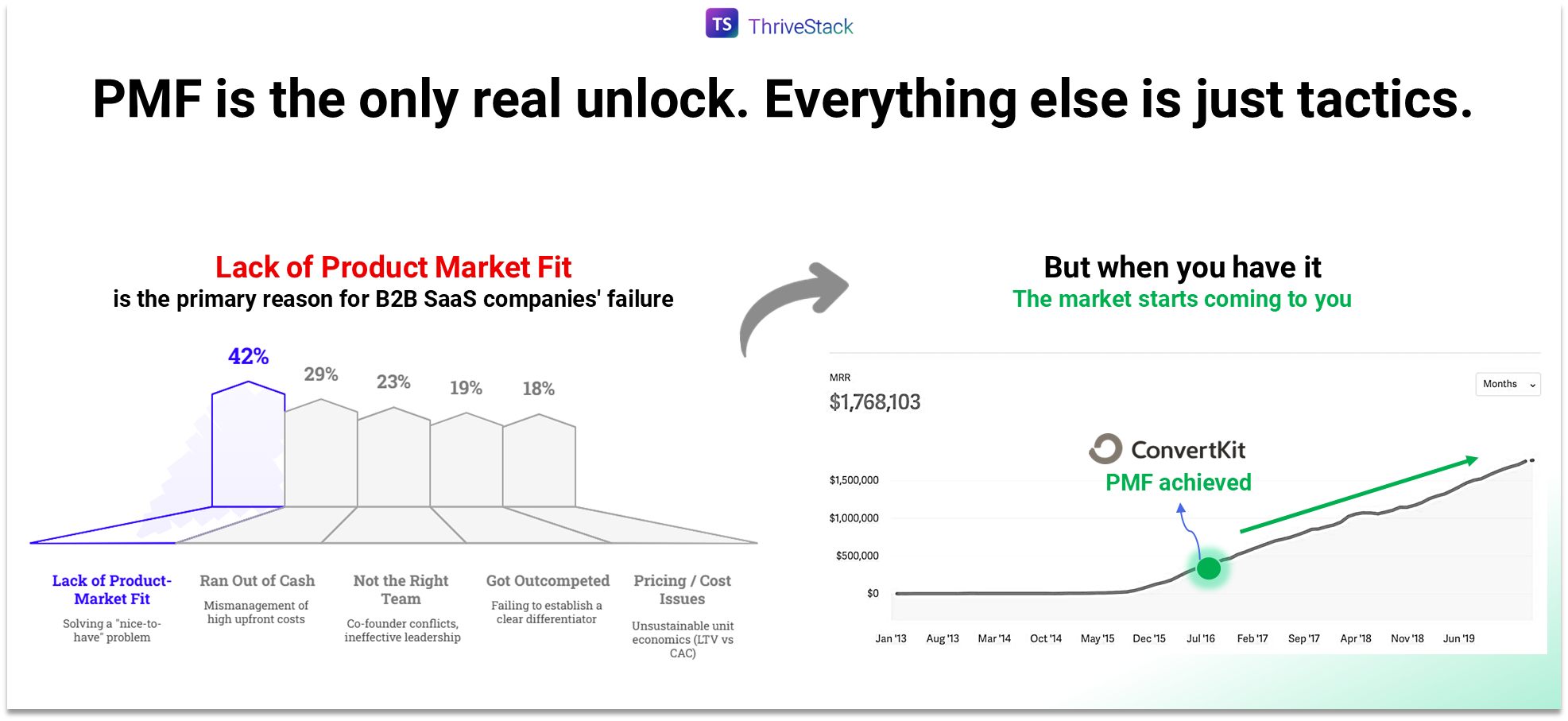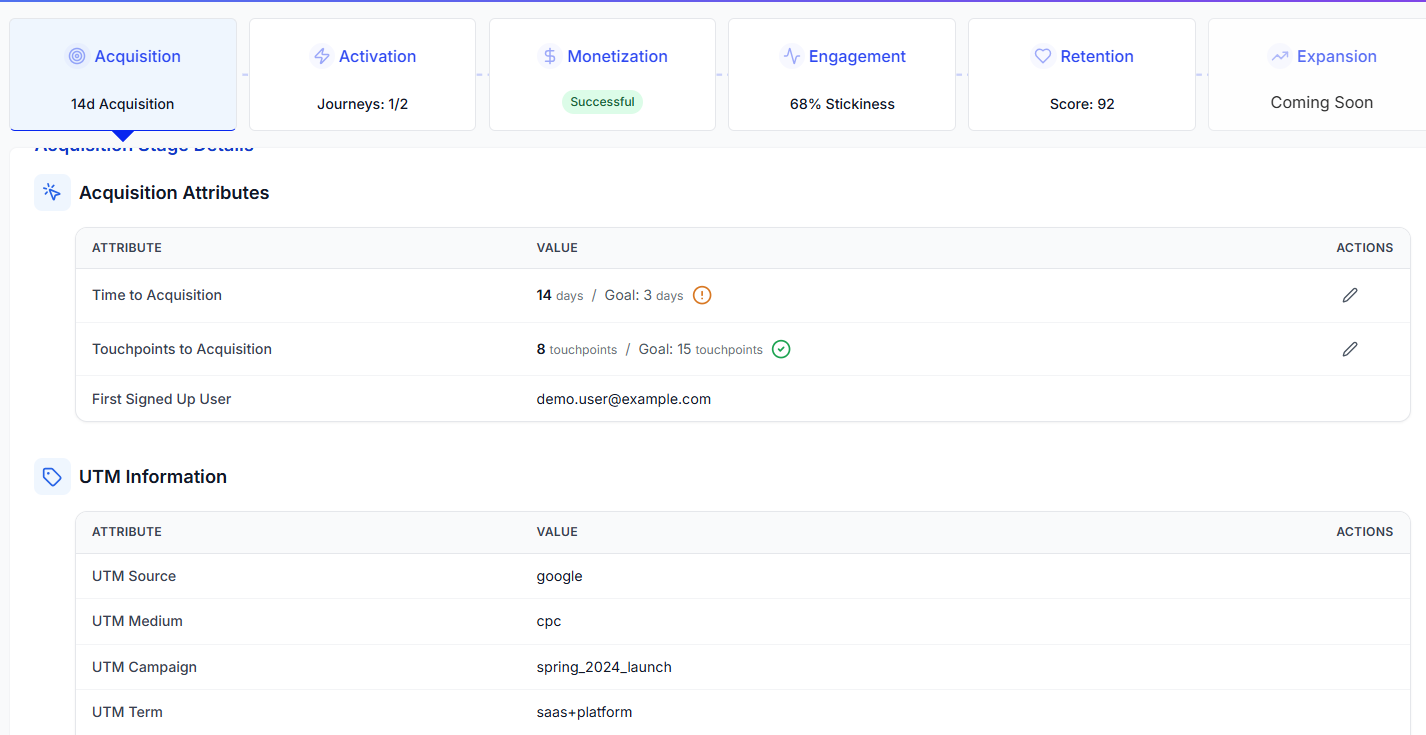Amplitude measures Clicks, ThriveStack measures Growth
Why Choosing the Right Analytics Platform Matters in 2025
In the ever-evolving world of SaaS, having the right analytics platform can make or break your growth trajectory. With customer expectations higher than ever, and product experiences driving long-term value, B2B SaaS companies need tools that go beyond surface-level data. That’s where ThriveStack and Amplitude come into play—two powerful platforms with very different philosophies.
Amplitude, with its roots in B2C and product analytics, focuses on click-level data. ThriveStack, on the other hand, is a modern Growth Intelligence platform built to help B2B SaaS teams track the entire customer journey, connecting marketing, product, revenue, and retention data.
With Amplitude pricing rising quickly as event volume scales, many SaaS teams are searching for Amplitude alternatives that combine growth, account, and revenue analytics in one platform.
This is where ThriveStack shines. Unlike Amplitude, which remains optimized for B2C or PLG product teams, ThriveStack helps B2B SaaS startups connect acquisition, activation, and retention data in one place.
What Is ThriveStack Customer Analytics?
Growth Intelligence Platform Overview
ThriveStack Customer Analytics (TCA) isn’t just another analytics dashboard. It’s a Growth Intelligence platform built specifically for modern B2B SaaS teams. Unlike traditional analytics tools that silo data, ThriveStack connects every touchpoint—from marketing campaigns to product usage, from sales/revenue to renewals—into one seamless flow.
Bow-Tie Revenue Architecture Explained
ThriveStack’s secret sauce lies in its Bow-Tie Revenue Architecture, a powerful data model that stitches together the entire customer journey. It captures data across acquisition, activation, retention, revenue, and referrals—giving a complete view of growth levers and friction points.
Designed for Full-Funnel SaaS Growth
By integrating CRM data, product usage, customer support interactions, and billing metrics, ThriveStack provides end-to-end visibility. This holistic approach empowers teams to optimize not just for clicks, but for outcomes—like pipeline velocity, expansion revenue, and churn prevention.
Want to see how ThriveStack connects marketing, product, and revenue data into one source of truth? Read our deep dive on ThriveStack Customer Analytics
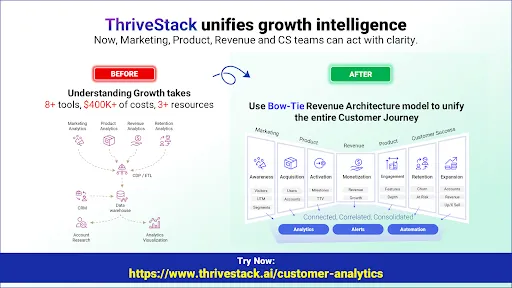
What Is Amplitude?
Product Analytics Legacy
Amplitude started as a product analytics tool aimed at helping consumer app teams understand how users interact with digital products. Over time, it has evolved, adding more features and modules. Yet, its core still centers around tracking events and clicks to help teams improve user retention and conversion within apps.
Website Click Tracking Capabilities
Amplitude excels at event-based tracking—analyzing how users click, scroll, or navigate through a website or app. This is great for consumer tech products or mobile-first platforms where event-level behavior is the main success metric.
B2C Origins and Shift Toward B2B
Although Amplitude now supports some B2B use cases, its data model and pricing structure still lean heavily toward enterprise B2C environments. For B2B SaaS teams that need account-level insights or CRM integration, the learning curve and cost can be significant.
Target Market: Who Are These Platforms Built For?
ThriveStack: Ideal for SMB and Mid-Market B2B SaaS
If you're a growing B2B SaaS company—especially in the small to mid-market space—ThriveStack is built for you. Whether you're a marketing manager tracking campaign-to-close, or a customer success team monitoring retention risk, ThriveStack gives everyone a shared lens into customer growth.
Amplitude: Better Suited for Enterprise B2C Products
Amplitude shines when used by large enterprise product teams in B2C industries, such as e-commerce or mobile gaming. Its infrastructure handles high-volume event tracking well, but struggles to offer actionable insights for multi-stakeholder B2B journeys.
Feature Comparison: ThriveStack vs Amplitude
Customer Journey & Funnel Tracking
ThriveStack: Unified View with CRM, Revenue, Retention
ThriveStack brings together all data streams—marketing touchpoints, product events, CRM stages, billing milestones—into one journey map. It enables teams to measure what drives actual growth, not just what users click on.
.webp)
Amplitude: Limited Funnel Visibility without Add-ons
Amplitude requires heavy customization or paid add-ons to replicate similar funnel views, especially for account-based analytics. Without expensive upgrades, you're often left with fragmented insights.
Account Analytics & Auto-Enrichment
ThriveStack: Default & Seamless
Every ThriveStack account comes with built-in account analytics, auto-enrichment (like firmographics, technographics), and real-time alerts—no extra cost, no third-party dependence.
Amplitude: Complex, Expensive, Add-On Dependent
Account-level visibility in Amplitude is not standard and often requires integrating costly third-party tools or paying for premium tiers.
Marketing, Product, Revenue, and CS Alignment
ThriveStack was built for cross-functional alignment. Marketing teams see lead sources that convert; product teams identify features that drive upgrades; CS teams get churn alerts before it’s too late. Amplitude, while strong in product analytics, doesn’t naturally connect these dots.
Alerts, Automation, and Workflow Triggers
ThriveStack includes real-time alerts and workflow automations as core functionality. Amplitude relies more on integrations or exports to external systems for similar results.
Persona Fit: Who Benefits Most?
ThriveStack for Marketing, Product, Revenue & CS Teams
Whether it’s marketing attribution, product engagement, sales pipeline conversion, or customer retention, ThriveStack empowers every persona with actionable insights.
Amplitude for Product-Led Growth & Analysts
Amplitude is a better fit for data analysts and product managers in PLG companies who focus on optimizing user onboarding, activation, and feature usage.
Pricing Models & Affordability
ThriveStack’s Accessible Model for B2B SaaS
ThriveStack is priced for scalability and transparency, giving B2B SaaS companies access to enterprise-grade insights without enterprise bloat. Most core features are included by default.
See our full ThriveStack Pricing Plans to understand cost tiers and growth limits.
Amplitude’s Pricing and Add-On Costs
Amplitude starts free but quickly becomes expensive, especially as your event volume or team size grows. Critical features like account analytics are locked behind premium plans.
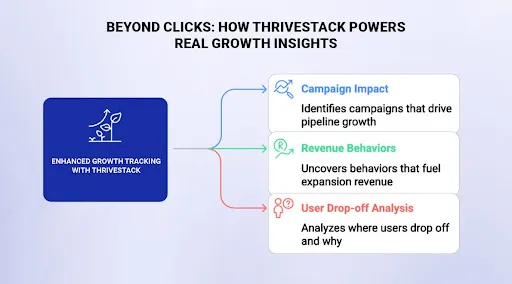
Data Modeling: Clicks vs Growth
Why ThriveStack Tracks Growth, Not Just Clicks
Clicks are just the beginning. ThriveStack helps you answer:
- Which campaigns generate pipeline?
- Which product behaviors lead to expansion revenue?
- Where are users dropping in the journey—and why?
It’s growth intelligence, not vanity metrics.
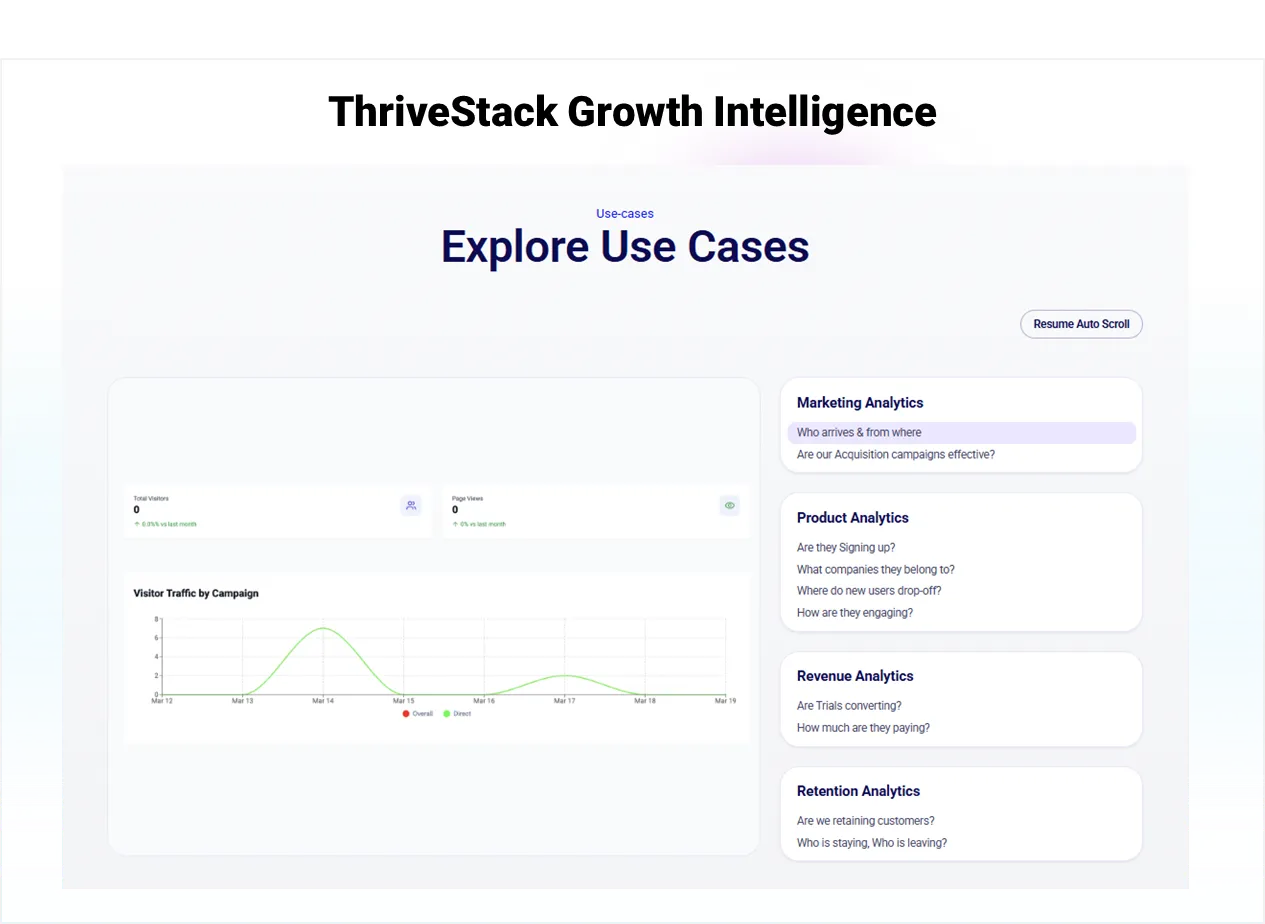
Amplitude’s Click-Centric Tracking Philosophy
Amplitude’s strength is in capturing and analyzing events—what users do, when, and how often. But it often misses the “so what?” behind those actions, especially in complex B2B journeys.
Use Cases: Real-Life Scenarios
Different companies have different analytics needs depending on their product, customer journey, and team structure. While some thrive with a granular, event-based analytics tool, others need a more unified, journey-centric view to align Marketing, Product, and Revenue teams around one version of truth.
Below are two real-world scenarios that show how choosing the right approach makes all the difference:
Example: B2B SaaS Startup with a Complex Customer Journey
A mid-size B2B SaaS company struggled to align Marketing, Product, and Revenue data. Using ThriveStack, they connected email campaigns, in-app behavior, and CRM pipeline stages into one continuous view.
This helped them identify drop-off points, understand which users were most likely to churn, and proactively retain them. Over time, they also uncovered the signals that predicted upsell readiness—boosting expansion revenue without needing more tools.
Example: Large B2C Enterprise Focused on App Metrics
A mobile gaming enterprise with millions of daily users relies on Amplitude to monitor feature adoption and improve session length. With its powerful event-based tracking and A/B testing capabilities, Amplitude helped them optimize onboarding flows and test in-game mechanics.
For a high-volume, click-heavy use case where deep behavioral analytics is key, Amplitude proved to be the right choice.
Pros and Cons: ThriveStack vs Amplitude
ThriveStack Pros & Cons
Pros:
- Built for B2B SaaS
- Full-funnel visibility
- Default CRM and account analytics
- Unified platform for all teams
Cons:
- Not ideal for ultra high-volume B2C apps
Amplitude Pros & Cons
Pros:
- Powerful product analytics
- Great for B2C and event-heavy use cases
Cons:
- Account analytics are extra
- Limited CRM visibility
- Pricing escalates quickly
Which Platform Should You Choose in 2025?
If you're a B2B SaaS company, ThriveStack offers better value, visibility, and team alignment. For consumer-facing apps focused on product tweaks and event tracking, Amplitude may suffice—but you'll miss the broader growth picture.
Absolutely! Here's a comprehensive comparison chart between ThriveStack and Amplitude, with an additional row comparing alternative tools like Mixpanel, Woopra, and June.so for account analytics context.
ThriveStack vs Amplitude: Full Feature Comparison (2025)
Legend:
✅ = Included / Strong
⚠️ = Partial / Limited
❌ = Not Available or Requires Add-on
Are There Better Alternatives Than Amplitude?
While Amplitude is rooted in user-based event tracking, ThriveStack offers actionable growth insights that span the entire customer lifecycle—from lead acquisition to revenue expansion and retention.
It’s important to note that user session tracking and mouse movement monitoring—features once considered premium—are now widely available for free through platforms like Microsoft Clarity, Hotjar, and Mixpanel. These tools cover basic behavioral analysis but still fall short when it comes to account-level insights, which are crucial for B2B SaaS.
When it comes to account-level analytics, here’s how the market looks:
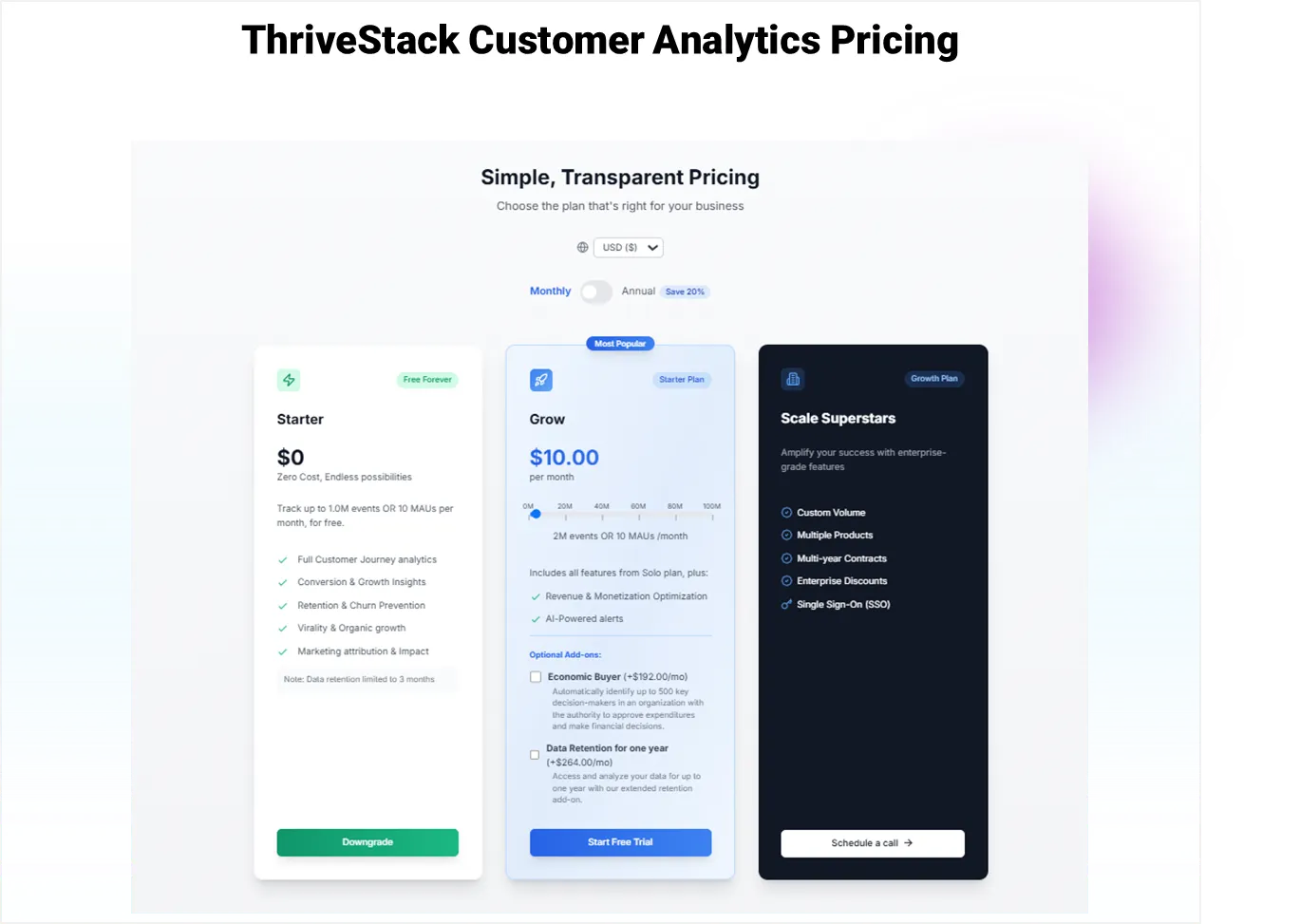
With pricing that starts free and scales from just $10/month, ThriveStack has effectively democratized account-level analytics. It empowers small and mid-sized SaaS companies to harness enterprise-grade insights without breaking the bank.
If you're looking for a cost-effective, full-funnel, growth-focused analytics solution,
ThriveStack is not just an alternative to Amplitude—it’s the smarter choice for B2B SaaS in 2025.
Conclusion: Growth Intelligence Is the Future of SaaS Analytics
In 2025, Amplitude analytics still serve event-heavy B2C products well. But for B2B SaaS teams needing customer, account, and revenue intelligence, ThriveStack is the clear winner.
If you’re evaluating Amplitude company overview 2025 reports or looking into Amplitude Growth Plan limitations, the takeaway is simple: Amplitude measures clicks—ThriveStack measures growth.
See How ThriveStack Powers B2B SaaS Growth – Book a Demo Today!
Frequently Asked Questions (FAQs)
1. Is ThriveStack better for B2B SaaS than Amplitude?
Yes! ThriveStack is purpose-built for B2B SaaS with CRM, account analytics, and full-funnel tracking.
2. Does Amplitude offer account-level analytics?
Only on expensive plans or with account analytics as an add-on. ThriveStack includes in all plans, including the free strarter plan.
3. Does Amplitude offer auto-enrichment for Users and Companies?
No, Amplitude was not built for business growth analytics. ThriveStack includes in all plans, including the free strarter plan.
4. What is the Bow-Tie Revenue Architecture in ThriveStack?
It’s a data model connecting marketing, product, sales, and retention into one unified customer journey.
4. Who should use ThriveStack?
Marketing, product, engineering, revenue, and CS teams at small and mid-size SaaS companies.
5. Can I replace Amplitude with ThriveStack?
If you need deeper customer journey insights across teams, yes—ThriveStack is a strong upgrade.
6. Is ThriveStack affordable for startups?
Yes! it’s designed with SMBs and scaling SaaS in mind.


